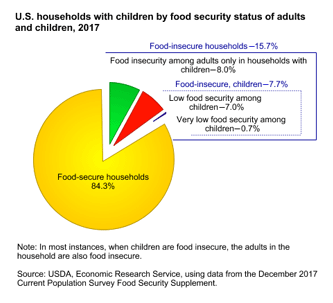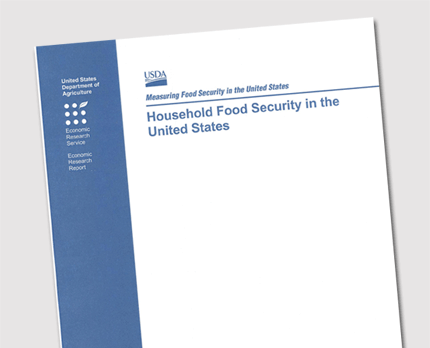The USDA defines food insecurity as a state in which “consistent access to adequate food is limited by a lack of money and other resources at times during the year.” Food insecurity is not a synonym for hunger rather it’s a term that is applied to populations that are struggling to avoid hunger. The Economic Research Service (ERS), a department within the USDA, publishes an annual survey that measures the Nation’s food security.
The very concept of measuring food insecurity is fairly new as it dates back to the mid 1990’s. But there are critics of the food security system. They charge that the system does not measure hunger in America rather it measures individuals feelings about their place on the economic ladder. Further they claim that the annual survey itself is broken and has become a political tool. The primary problem is that food insecurity has become the new way of defining hunger. The fact is that the USDA doesn’t have a measurement for hunger. Yet it only takes a few simple web searches to see that the food insecurity moniker has replaced hunger in the daily lexicon. The query “how many people in the United States suffer from hunger” leads one to believe that 41 million of our fellow Americans are starving. There are then pages of pages of articles that use the data included in USDA to report on Hunger in America. All this despite the fact that the USDA itself warns that food security data does not represent how many Americans suffer from hunger.
 Like many reports that are complex the public is presented with top-line statistics and charts. These summary findings often become the basis for media articles that do not explain the findings in detail. So charts like the one that shows there 15.7% of households are “food insecure” get re-purposed to support the idea that nearly 16% of American households are going hungry. Another problem that some point to is the fact that the USDA has very different standards for measuring food security in the US versus how it measures food security for foreign countries.
Like many reports that are complex the public is presented with top-line statistics and charts. These summary findings often become the basis for media articles that do not explain the findings in detail. So charts like the one that shows there 15.7% of households are “food insecure” get re-purposed to support the idea that nearly 16% of American households are going hungry. Another problem that some point to is the fact that the USDA has very different standards for measuring food security in the US versus how it measures food security for foreign countries.
In the U.S. data are compiled based upon surveys conducted on about 37,000 of America’s 127 million households. The 18 questions primarily focus on affordability of balanced meals and other economic conditions. Based on this survey, last conducted in 2017, the USDA estimates that 40 million people, including more than 12 million children, in the United States are food insecure. The media and certain organizations often report from this that nearly 12% of the U.S. population is in danger of starvation. Intentionally or not, these reports tend to feed off each other and while hunger in America is an real issue that demands attention, there are not 40 million of our fellow citizens who are starving.
When the Federal government estimates “food security” for foreign nations it bases its findings not on affordability but on whether residents consume at least 2,100 calories per day. This represents the average calorie level necessary to sustain life at a moderate level of activity. Using this caloric standard as a measurement standard brings about very different “food security” numbers for foreign countries than it does for the United States. According to USDA, most developing nations have zero problem with “food security”. Compare this to the words of President Obama, who announced after the 2009 food security report was released, that “hunger rose significantly last year … . My administration is committed to reversing the trend of rising hunger.”
Because there is no real attempt at the Federal level to monitor and measure actual hunger, food security as a term has supplanted hunger in the public space. Critics charge that the agency is invested in measuring “food insecurity,” because it produces vastly higher numbers which in turn are used to justify expanding federal food programs. They ask whether an honest survey of the actual hunger problem in America could wreak havoc on bureaucratic job security.
You do not have to be a social scientist to determine that food insecurity in America has been conflated with hunger in America. And to be clear there are many Americans who are faring quite badly. Poverty in America is a real issue and there and some Americans suffer from real hunger. However, since the USDA has never tried to get a clear count of how many people are actually hungry, and where these people live, it makes it harder to come up with lasting solutions to eradicate hunger in one of the richest countries on earth.

